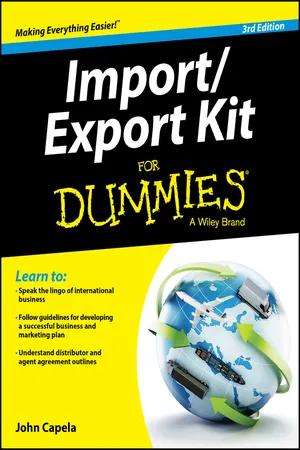
- English
- ePUB (mobile friendly)
- Available on iOS & Android
Import / Export Kit For Dummies
About this book
Your easy-to-follow primer on the exciting world of import/export
With an increased focus on global trade, this new edition of Import/Export Kit For Dummies provides entrepreneurs and small- to mid-sized businesses with the critical, entry-point information they need to begin exporting their products around the world—as well as importing goods to sell. Inside, you'll find the most up-to-date information on trade regulations, where to turn for additional guidance on seamlessly navigating the dreaded red tape, and much more.
With significant changes in technology, expanding economics, and international trade agreements, the global marketplace continues to grow and change rapidly. In fact, companies that do business internationally are proven to grow faster and fail less often than companies that don't. This authoritative reference is packed with everything you need to get started, so why not get in on the game while the going is good?
- Gets you up to speed on the lingo of international business
- Shows you how to follow guidelines for developing a successful business and marketing plan
- Helps you understand distributor and agent agreement outlines
- Offers unprecedented insight on pinpointing the right markets for your import/export business
Importing and exporting goods is a valuable way to expand your business and take part in the global economy, and this hands-on, friendly guide shows you how.
Frequently asked questions
- Essential is ideal for learners and professionals who enjoy exploring a wide range of subjects. Access the Essential Library with 800,000+ trusted titles and best-sellers across business, personal growth, and the humanities. Includes unlimited reading time and Standard Read Aloud voice.
- Complete: Perfect for advanced learners and researchers needing full, unrestricted access. Unlock 1.4M+ books across hundreds of subjects, including academic and specialized titles. The Complete Plan also includes advanced features like Premium Read Aloud and Research Assistant.
Please note we cannot support devices running on iOS 13 and Android 7 or earlier. Learn more about using the app.
Information
Getting Started with Import/Export







Introducing Import/Export


Importance of Trade to the Economy
- Speed of communication: Advancements in transport and communications make people more aware of business developments elsewhere and enable them to take advantage of opportunities. Not only is it now much cheaper to operate internationally and trade with foreign partners, but because of the Internet, potential buyers and sellers can exchange information more efficiently.
- Lower barriers: Trade barriers between countries have fallen and are likely to continue to fall.
Defining the Import/Export Business
Exporting: Do you want what I’ve got?
- Direct exporting: Direct exporting is a business activity occurring between an exporter and an importer without the intervention of a third party. This option is good for existing businesses that are looking for ways to expand their operations.
- Indirect exporting: Indirect exporting is easier than direct exporting. It involves exporting goods through various intermediaries in the producer’s country. Indirect exporting doesn’t require any expertise or major cash expenditures, and it’s the type of exporting used most often by companies that are new to exporting.
Looking at types of indirect exporting
Dedicated exporting: Export management companies
Piggyback exportin...
Table of contents
- Cover
- Title Page
- Table of Contents
- Introduction
- Part I: Getting Started with Import/Export
- Part II: Selecting Products and Finding Suppliers
- Part III: Identifying Your Target Market and Finding Customers
- Part IV: Negotiating Around the World
- Part V: Completing the Transaction: International Trade Procedures and Regulations
- Part VI: The Part of Tens
- Part VII: Appendixes
- About the Author
- Cheat Sheet
- Advertisement Page
- Connect with Dummies
- End User License Agreement

